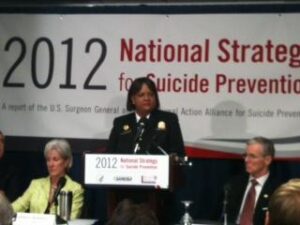
On Sept. 10, the National Action Alliance for Suicide Prevention (Action Alliance), along with Health and Human Services Secretary Kathleen Sebelius and Surgeon General Regina Benjamin, revealed the revised version of the National Strategy for Suicide Prevention (NSSP). The strategy, revised after nearly a decade of research, aims to place more focus on the roles Americans can play in protecting friends, family members and colleagues from suicide. The NSSP also aims to help schools, businesses and health systems create guidelines of their own and lead the way in suicide prevention activities in the future.
“We are in a unique position to make significant progress in reducing the burden of suicide in our country,” said Jerry Reed, director of the Suicide Prevention Resource Center (SPRC) in a press release. “With the release of this revised strategy and the focus on its first four priorities, the Action Alliance is leading the suicide prevention agenda at the national level.”
Reed co-led the Action Alliance task force, along with Surgeon General Benjamin, that guided the revision process.
The revised NSSP features 13 goals and 60 objectives to advance suicide prevention. The Action Alliance has chosen four priorities to focus on first with the aim of saving 20,000 lives in the next five years. The Action Alliance said that it chose these priorities because of their “potential to produce the systems-level change necessary to substantially lower the burden of suicide in our nation.”
The Action Alliance stated the following as its initial priorities:
1. Integrate suicide prevention into health care reform and encourage the adoption of similar measures in the private sector. The Action Alliance will work in partnership with the Centers for Medicare and Medicaid Services (CMS) to take advantage of the exceptional opportunities health care reform offers to make large-scale system changes that can prevent suicide and save lives. Successful integration into health care reform will naturally spill over into private health systems.
2. Transform health care systems to significantly reduce suicide. The Action Alliance will promote the adoption of “zero suicides” as an organizing goal for clinical systems by providing support for efforts to transform care through leadership, policies, practices and outcome measurement. This priority will build on the momentum of the 2011 report released by the Action Alliance’s Clinical Care and Intervention Task Force, Suicide Care in Systems Framework. The Action Alliance will recruit pioneer health and behavioral health systems from across the country to implement this innovative framework within their respective organizations and will provide the support and tools needed to provide state-of-the art suicide care.
3. Change the public conversation around suicide and suicide prevention. The Action Alliance will leverage the media and national leaders to change the narratives around suicide and suicide prevention to ones that promote hope, connectedness, social support, resilience, treatment and recovery. Current media coverage and messaging around suicide can often do more harm than good by using language and ideas that make suicide seem more common than it actually is, especially when it is a response to difficult situations such as bullying, financial crisis and repeated exposure to military combat. This priority will instead be to promote stories about individuals who struggled with difficult situations, yet were resilient, found help or treatment, and established a stronger will to go on living. In reality, this is what happens the vast majority of the time. It will also promote the cultural norm of providing help and support to vulnerable members of our communities, and through that, change the course for those who are struggling with thoughts of suicide.
4. Increase the quality, timeliness and usefulness of surveillance data regarding suicidal behaviors. The Action Alliance will work with the Centers for Disease Control and Prevention and other public and private partners to markedly improve statistics on suicidal behaviors. Currently, there is a three-year lag time with national suicide data. Speeding up the release of these data will allow policy and program developers to better understand the problem of suicide, monitor real-time trends in suicidal behavior and assess the effectiveness of suicide prevention work .
Click here to read the latest version of the NSSP. For more information about the Action Alliance, visit actionallianceforsuicideprevention.org.
Heather Rudow is a staff writer for Counseling Today. Email her at hrudow@counseling.org.
